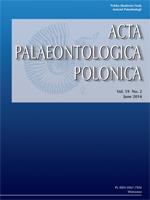In this paper well-preserved isoetalean microsporophyll, containing in situ microspores, is described from the uppermost part of the Utrillas Formation (latest Albian) in Teruel Province, northeastern Spain. Similar but dispersed microspores were described previously as Peromonolites. Fossil plant impressions and compressions including the sporophyll lamina and microsporangium are referred to the fossil genus Isoetites. Although Isoetes-like megafossil remains, often with in situ or associated megaspores, are known from quite a few Cretaceous sites, and dispersed microspores are known, the presence of intact microsporangia is rare. Herein we suggest that microsporangia may have dispersed in masses, possibly representing a new unknown strategy in microspore dispersal in this group of plants.
How to translate text using browser tools
1 June 2014
A New Isoetalean Microsporophyll from the Latest Albian of Northeastern Spain: Diversity in the Development and Dispersal Strategies of Microspores
Uxue Villanueva-Amadoz,
Luis Miguel Sender,
José Bienvenido Diez,
José Javier Ferrer,
Denise Pons

Acta Palaeontologica Polonica
Vol. 59 • No. 2
June 2014
Vol. 59 • No. 2
June 2014
Albian
Isoetales
Isoetites
Lycophyta
microsporophyll
Peromonolites
Spain




